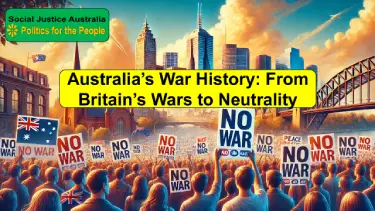Description
Australia’s war history. Explore our history of supporting Britain’s wars and U.S. conflicts and how Australia can transform into a neutral, peace-promoting nation.
Introduction
 Australia’s military history reflects a long-standing pattern of aligning with powerful allies—first Britain and later the United States—participating in wars that often had little to do with defending the nation. For much of its history, Australia supported Britain’s imperial wars, following colonial obligations rather than national interests.
Australia’s military history reflects a long-standing pattern of aligning with powerful allies—first Britain and later the United States—participating in wars that often had little to do with defending the nation. For much of its history, Australia supported Britain’s imperial wars, following colonial obligations rather than national interests.
After WWII, this allegiance shifted to the United States, entangling Australia in a series of wars of aggression driven by the U.S. military-industrial complex. This article explores how Australia can break free from this legacy, embrace neutrality, and lead as a global peace advocate.
Australia’s History of War Involvement
Australia’s Support of Britain’s Wars
Before WWII, Australia was deeply entrenched in Britain’s military campaigns as part of the British Empire. Significant examples include:
1. Boer War (1899–1902):
– Australia sent over 16,000 troops to fight in South Africa in support of Britain’s imperial ambitions, resulting in significant loss of life and the further colonisation of Africa.
– Critics argue this war had little relevance to Australian security and primarily served Britain’s interests.
2. World War I (1914–1918):
– Over 400,000 Australians enlisted, and 60,000 died in a war that symbolised Australia’s loyalty to Britain.
– Campaigns like Gallipoli exemplified the cost of fighting wars far from home without direct benefit to Australia.
3. Other Imperial Wars:
– Australian troops also supported Britain in minor conflicts, such as the Boxer Rebellion (1900) in China, reflecting Australia’s subordinate role in British imperial strategy.
These wars, often glorified in Australian history, were not fought for national defence but as extensions of Britain’s imperial ambitions.
Post-WWII Shift to U.S. Alliance
After WWII, Australia’s geopolitical alignment shifted from Britain to the United States. This realignment reflected the changing global power dynamic as the U.S. emerged as a dominant military and economic force. However, this shift has drawn Australia into several conflicts with questionable justification, often serving U.S. interests rather than Australian security.
1. Origins of the U.S.-Australia Alliance
– The ANZUS Treaty (1951):
Signed during the Cold War, the ANZUS Treaty formalised Australia’s military alliance with the U.S. and New Zealand. This treaty promised mutual defence, but it has often resulted in Australia supporting U.S.-led military actions without receiving equivalent support for its regional concerns.
– Fear of Communism:
Australia’s alignment with the U.S. was also driven by the perceived threat of communism during the Cold War. The domino theory—the belief that communism would spread across Southeast Asia—led Australia to commit to U.S.-led wars in the region.
2. Key U.S.-Led Wars and Australia’s Role

Vietnam War (1962–1973):
– Australia was the first U.S. ally to commit troops to Vietnam, sending nearly 60,000 personnel throughout the war.
– The conflict, driven by Cold War fears, cost Australia over 500 lives and left thousands of veterans with lasting physical and psychological scars.
Public opposition to the war grew, culminating in large-scale protests and questions about Australia’s blind allegiance to U.S. policy.
Iraq War (2003)
– Australia joined the U.S.-led invasion of Iraq under the pretext of dismantling weapons of mass destruction—a claim later proven false.
– The war destabilised the Middle East, contributed to the rise of extremist groups like ISIS, and inflicted immense suffering on Iraqi civilians.
– Australia’s involvement was heavily criticised domestically, with many questioning the lack of parliamentary debate before committing troops.
Public Opposition and Ignoring the People’s Voice:
– Leading up to the invasion, hundreds of thousands of Australians participated in some of the largest anti-war demonstrations in the country’s history.
– February 2003 Protests: Over 600,000 people marched in major cities like Sydney, Melbourne, and Brisbane, with protesters carrying signs like “Not in My Name” and “No Blood for Oil.”- These protests were part of a global movement against the Iraq War, reflecting widespread discontent with unilateral military action.
– Despite overwhelming public opposition, the Howard government disregarded these demonstrations and committed Australia to the war.
– Then, Prime Minister John Howard aligned closely with U.S. President George W. Bush, prioritising the alliance over the wishes of Australian citizens.
– Howard justified the decision by invoking Australia’s alliance obligations and unproven claims about Iraq’s possession of weapons of mass destruction.
– The government’s decision to ignore the most significant public outcry in Australian history deepened distrust in political leadership and highlighted the democratic deficit in war decisions.
This blatant disregard for public opinion resonates as a symbol of the Howard government’s willingness to follow U.S. directives at the expense of Australian democracy and ethical accountability.
Afghanistan War (2001–2021):
– Following the 9/11 attacks, Australia joined the U.S. invasion of Afghanistan to eliminate al-Qaeda and the Taliban.
– The 20-year conflict cost Australia $10 billion and resulted in 41 Australian soldiers killed, with many more suffering from PTSD.
– Despite significant investment, the war ended with the Taliban regaining control, raising questions about its objectives and outcomes.
Other Conflicts:
Australia has also supported U.S. military operations in smaller-scale conflicts, including Syria and Libya, further entrenching its role as a subordinate partner in the U.S.’s global military strategy.
3. The Costs of Aligning with the U.S.
Human Costs:
– Lives Lost and Trauma Among Soldiers:
– Thousands of Australian soldiers have been deployed to U.S.-led wars, with hundreds losing their lives. Those who return often face significant physical injuries and mental health issues, such as post-traumatic stress disorder (PTSD).
– According to the Department of Veterans Affairs, suicide rates among Australian veterans are significantly higher than in the general population, reflecting the long-term human toll of these conflicts.
– Civilian Casualties and Refugee Crises:
– Australia’s involvement in U.S.-led wars has directly contributed to the displacement of millions of civilians in conflict zones. For example, the Iraq War displaced an estimated 4.7 million people, with many forced to flee their homes due to violence, destroyed infrastructure, and political instability. Similarly, the war in Afghanistan left millions homeless and seeking asylum in neighbouring countries or beyond.
– Refugee crises have cascading effects, overwhelming host nations and creating long-term humanitarian challenges. These crises often destabilise entire regions, fostering cycles of poverty, political instability, and further violence.
– Australia’s Role in Refugee Responses:
– Despite contributing to the conditions that drive these crises, Australia has faced criticism for its restrictive asylum policies, particularly its offshore detention program. Refugees from wars like those in Iraq and Afghanistan have often been met with harsh border policies instead of receiving the support and protection they desperately need.
– This disconnect between Australia’s participation in creating refugee crises and its treatment of refugees highlights the ethical and moral contradictions in its foreign and domestic policies.
These wars have not only devastated the regions where they were fought but also created humanitarian emergencies that continue to ripple across the globe. Australia’s involvement in such conflicts has placed it at the heart of these crises, raising pressing questions about its responsibility to support those displaced by wars it helped facilitate.
Economic Costs:
– The financial burden of participating in U.S.-led wars is staggering.
– For example, the Iraq War alone cost Australia billions, diverting public money from essential services like healthcare, education, and infrastructure.
Strategic Costs:
– Australia’s reliance on the U.S. has eroded its ability to pursue an independent foreign policy.
– The alliance has also strained Australia’s relations with neighbouring countries, particularly in the Indo-Pacific, as they view Australia as an extension of U.S. military power.
4. The Role of the U.S. Military-Industrial Complex
– The U.S. military-industrial complex—the network of defence contractors, lobbyists, and policymakers—has driven America’s aggressive foreign policy.
– Australia’s involvement in U.S.-led wars has indirectly supported this system, contributing to a cycle of perpetual conflict for profit.
– By aligning with the U.S., Australia has become complicit in wars designed not for peace but for the economic gains of a few powerful corporations.
The Impact of Australia’s War History
Social and Political Consequences
1. Loss of Sovereignty
– Dependency on Foreign Powers:
– Aligning with British and U.S. foreign policy has entrenched a culture of dependency, where Australia’s decision-making on international matters is heavily influenced—if not dictated—by its more powerful allies. Australia’s war history has created a dependency that has eroded Australia’s ability to pursue an independent foreign policy that aligns with its national interests.
– Australia as a Powerless Victim of U.S. Influence:
– Australia’s unwavering alignment with the U.S. has sometimes rendered it a powerless victim of American geopolitical strategies. By uncritically following the U.S. into conflicts like the Iraq and Afghanistan wars, Australia has shouldered significant human, financial, and moral costs without meaningful input into the decision-making processes driving these wars.
– This subservience has positioned Australia as a tool in U.S. global dominance, where its military and political resources are leveraged to serve U.S. interests, often at the expense of Australia’s reputation and sovereignty.
Such dependency risks dragging Australia into future conflicts, even those that may be detrimental to its regional stability and national security, as seen in the increasing militarization of the Indo-Pacific under U.S. influence.
To reclaim its sovereignty, Australia must break free from this cycle of dependency and assert its right to an independent foreign policy. Only then can it prioritise its interests and values over those imposed by foreign powers.
2. Erosion of Public Trust:
– Australians increasingly question the wisdom of following allies into unnecessary conflicts, yet political leaders show little accountability.
Economic and Social Trade-offs
– While billions are spent on wars, over 100,000 Australians are homeless, and public hospitals are underfunded.
– Defence budgets prioritise military build-ups over renewable energy, education, and other critical areas.
Building a Neutral, Peace-Promoting Australia

Australia must take deliberate steps toward neutrality and peace-building to break free from Australia’s war history of involvement in unnecessary wars. These steps involve redefining its foreign policy, limiting military commitments, and focusing on diplomacy and domestic priorities. Here’s how this transformation can be achieved:
1. Policy and Legislative Changes: Ending Australia’s war history
– Amend the Defence Act:
Update the Defence Act to restrict Australian Defence Force (ADF) deployments to:
– United Nations-sanctioned peacekeeping missions.
– Direct defensive actions where Australia is under threat.
This would prevent future governments from sending troops to wars of aggression without proper justification.
– Declare Neutrality:
Enshrine a policy of neutrality in Australian law, similar to Switzerland’s stance. Neutrality would mean Australia refrains from participating in foreign conflicts unless directly threatened or to uphold international peace under UN mandates.
2. Ending Foreign Military Dependence
– Reassess ANZUS and the U.S. Alliance:
While maintaining diplomatic ties, Australia should prioritise an independent foreign policy, ensuring its decisions serve national interests rather than those of foreign powers.
– Phase Out U.S. Military Bases:
Remove foreign military installations like Pine Gap gradually, which ties Australia to U.S. military operations. This move would assert Australia’s sovereignty and reduce entanglement in U.S.-led wars.
3. Promoting Diplomacy and Regional Stability
– Conflict Resolution Leadership:
Leverage Australia’s strategic location to mediate disputes in the Indo-Pacific region, focusing on peaceful resolutions rather than military involvement.
– Regional Cooperation:
Partner with ASEAN nations and Pacific Island countries to promote shared goals such as sustainable development, disaster preparedness, and regional security without militarisation.
4. Redirecting Military Spending
– Invest in Domestic Priorities:
Shift a significant portion of the defence budget to areas that directly benefit Australians, such as:
– Universal healthcare and affordable housing.
– Education and infrastructure development.
– Renewable energy projects to combat climate change.
– Support Global Aid Efforts:
Allocate funds to humanitarian aid and disaster relief, enhancing Australia’s reputation as a benevolent and peace-promoting nation.
5. Leveraging Monetary Sovereignty for Peace
Australia’s monetary sovereignty allows the federal government to create and allocate public money as needed. This enables the country to:
– Fund Neutrality Initiatives:
Develop programs and institutions that promote peace, diplomacy, and international cooperation without reliance on taxation or borrowing.
– Strengthen Domestic Resilience:
Invest in infrastructure, healthcare, and education to ensure Australians are well-supported, reducing the need for militarised responses to global challenges.
6. Educating the Public and Building Advocacy
– Public Awareness Campaigns:
Launch educational initiatives to inform Australians about the actual costs of war and the benefits of neutrality.
– Grassroots Movements:
Support and amplify peace-focused organisations and movements to ensure citizens’ voices are heard when shaping foreign policy.
By implementing these steps, Australia can become a global leader for peace, prioritising diplomacy and domestic well-being over military aggression.
Thought-Provoking Question
How can Australia move beyond its colonial and military past to establish itself as a global advocate for peace and neutrality?
Call to Action
If you found this article insightful, explore political reform and Australia’s monetary sovereignty on Social Justice Australia: https://socialjusticeaustralia.com.au/. Share this article with your community to help drive the conversation toward a more just and equal society.
Click on our “Reader Feedback” menu. Let us know how our content has inspired you. Submit your testimonial and help shape the conversation today!
Additionally, leave a comment about this article below.

